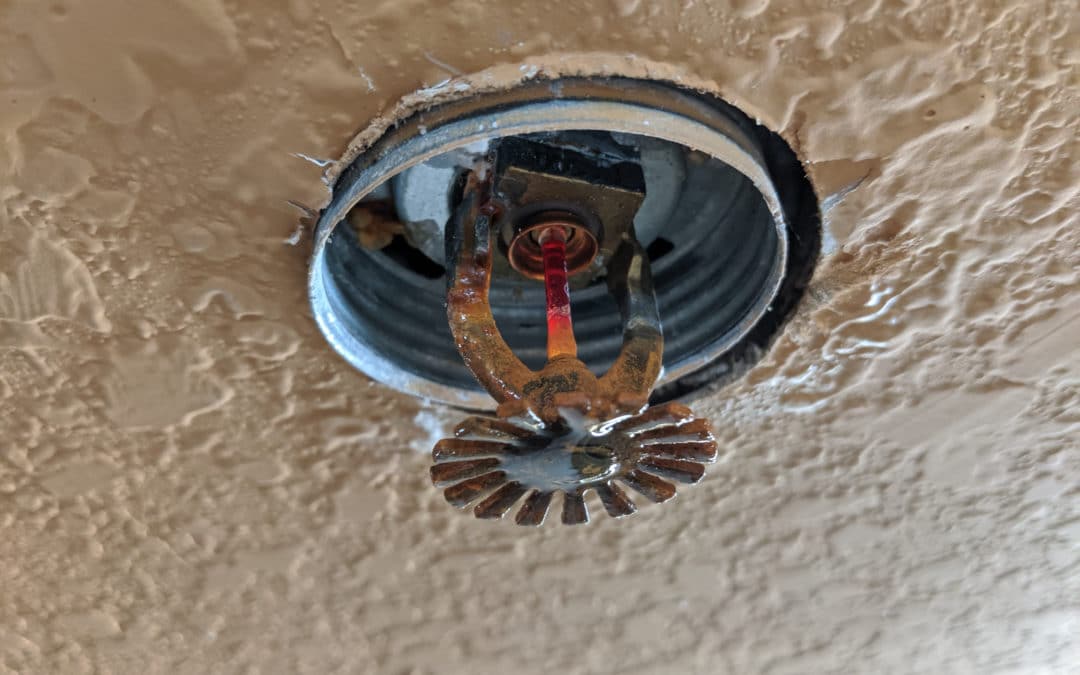But if corrosion levels start to spiral out of control, costly leaks and fire sprinkler obstructions are likely to occur. Fortunately, there are some preventative measures you can take to keep fire sprinkler system corrosion at bay. In this article, we’ll discuss more about corrosion and how to prevent it.
Causes of Corrosion in Fire Sprinkler Systems
Corrosion is the deterioration of a material due to a chemical reaction. Given that fire sprinkler systems contain metal, water, and oxygen, they create the perfect environment for corrosion to form.
The three most common and problematic types of corrosion within fire sprinkler systems are:
- Iron oxide corrosion — commonly referred to as rust
- Galvanic corrosion — when two or more dissimilar metals are in electrical contact under water
- Microbiologically influenced corrosion (MIC) — the presence and/or activity of microorganisms (e.g. bacteria, fungi) in biofilms on the corroding material
Dangers of Corrosion in Fire Sprinkler Systems
Unfortunately, for many facilities, fire sprinkler corrosion usually isn’t a matter of if, but when. And when the time comes where it gets to be too much, these costly and harmful problems can arise:
- Obstructions, which can either limit the flow of fire-extinguishing materials or rupture them altogether
- Temporary system shutdowns, which cause production halts and profit losses
- Complete system failure, which can result in harm to your property, products, and people in the case of a fire
- Total system replacement, which can cost up to three times more than the initial installation
4 Ways to Prevent Corrosion in Fire Sprinkler Systems
Preventing corrosion in your fire sprinkler system may sound like a challenging task, but with the right information and resources, you’ll be more than capable of keeping it at a safe level. Here are a few tips to get you started toward implementing and maintaining a corrosion-free (or at least low-corrosion) fire sprinkler system for your facility.
1. Choose A Corrosion-Resistant Pipe Material
If the most detrimental corrosion-inducing environment consists of metal, water, and oxygen, one way to reduce corrosion is to take metal out of the equation. Some materials, like chlorinated polyvinyl chloride (CPVC) or cross-linked polyethylene (PEX), provide more resistance to corrosion than traditional metals.
However, it’s important to remember that although corrosion is more common with metals, it’s not limited to them. Your fire sprinkler system may still experience corrosion with CPVC or PEX piping — it’s just likely to be less.
2. Replace Your Compressed Air System with a Nitrogen Generator
Another more viable and effective amendment you could make to the metal, water, and oxygen equation is to remove oxygen and replace it with a similar, yet corrosion-resistant gas: nitrogen.
Nitrogen is a stable, inert gas that’s non-reactive with metal. So, if you were to replace your current compressed air system with a nitrogen generator, your fire sprinkler system would face a much smaller risk of heavy corrosion — and with that, you’d be able to enjoy the following benefits:
- Fewer repairs on your fire sprinkler system
- Extended life expectancy of your fire sprinkler system
- Same size environmental footprint as oxygen
- Lower operating costs
3. Perform Regular Testing, Inspections & Maintenance
One of the best ways to prevent harmful amounts of corrosion in your fire sprinkler system is to follow the testing and inspection requirements set by the National Fire Protection Association (NFPA).
For water-based fire sprinkler systems, NFPA 25 requires an inspection of the internal condition of piping every five years. For dry and pre-action fire sprinkler systems, an inspection of the internal condition of piping is required every three years (usually during the regular full-flow trip test).
Staying disciplined and committed to these regular testing, inspection, and maintenance schedules is a great way to be proactive and catch corrosion problems early, before they’re a major cause for concern.
4. Be Aware of Possible Fire Sprinkler System Corrosion Indicators
If you’re in between regular testing and inspection years, you’ll want to be on the lookout for any warning signs that something’s not quite right in your fire sprinkler system. If you notice any of the following during other uses, tests, or servicing procedures, you may want to dive a little deeper to ensure there isn’t a larger problem at play:
- Plugged sprinklers
- Various pinhole leaks
- Defective intake for fire pumps
- Foreign material discharge in water or drain tests
- Foreign materials in fire pumps, dry pipe valves, or check valves
- 50% increase in the time it takes water to move to the test connection during a full-flow trip test, compared to an original system acceptance test (for dry systems only)
Fire sprinkler system corrosion prevention starts with regular inspections and maintenance. When you set up a maintenance schedule with the fire protection experts at Vanguard Fire & Security Systems, you’ll never have to worry about corrosion again. Our technicians come out on schedule to make sure every component of your fire protection system is functioning as it should. To learn more, contact our team online today.


